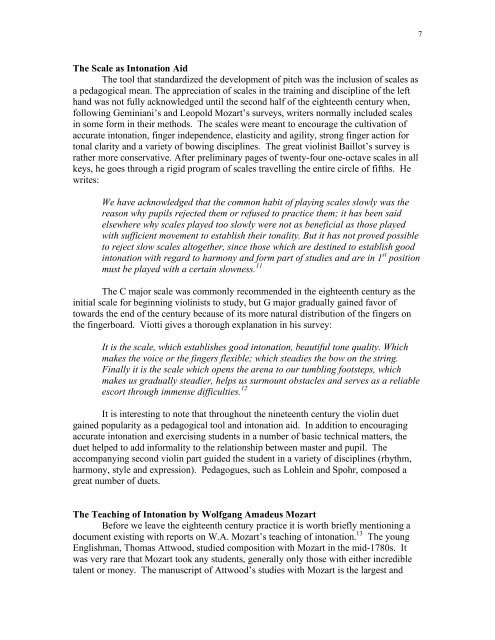A History of String Intonation - Borup, Hasse
A History of String Intonation - Borup, Hasse
A History of String Intonation - Borup, Hasse
Create successful ePaper yourself
Turn your PDF publications into a flip-book with our unique Google optimized e-Paper software.
The Scale as <strong>Intonation</strong> Aid<br />
The tool that standardized the development <strong>of</strong> pitch was the inclusion <strong>of</strong> scales as<br />
a pedagogical mean. The appreciation <strong>of</strong> scales in the training and discipline <strong>of</strong> the left<br />
hand was not fully acknowledged until the second half <strong>of</strong> the eighteenth century when,<br />
following Geminiani’s and Leopold Mozart’s surveys, writers normally included scales<br />
in some form in their methods. The scales were meant to encourage the cultivation <strong>of</strong><br />
accurate intonation, finger independence, elasticity and agility, strong finger action for<br />
tonal clarity and a variety <strong>of</strong> bowing disciplines. The great violinist Baillot’s survey is<br />
rather more conservative. After preliminary pages <strong>of</strong> twenty-four one-octave scales in all<br />
keys, he goes through a rigid program <strong>of</strong> scales travelling the entire circle <strong>of</strong> fifths. He<br />
writes:<br />
We have acknowledged that the common habit <strong>of</strong> playing scales slowly was the<br />
reason why pupils rejected them or refused to practice them; it has been said<br />
elsewhere why scales played too slowly were not as beneficial as those played<br />
with sufficient movement to establish their tonality. But it has not proved possible<br />
to reject slow scales altogether, since those which are destined to establish good<br />
intonation with regard to harmony and form part <strong>of</strong> studies and are in 1 st position<br />
must be played with a certain slowness. 11<br />
The C major scale was commonly recommended in the eighteenth century as the<br />
initial scale for beginning violinists to study, but G major gradually gained favor <strong>of</strong><br />
towards the end <strong>of</strong> the century because <strong>of</strong> its more natural distribution <strong>of</strong> the fingers on<br />
the fingerboard. Viotti gives a thorough explanation in his survey:<br />
It is the scale, which establishes good intonation, beautiful tone quality. Which<br />
makes the voice or the fingers flexible; which steadies the bow on the string.<br />
Finally it is the scale which opens the arena to our tumbling footsteps, which<br />
makes us gradually steadier, helps us surmount obstacles and serves as a reliable<br />
escort through immense difficulties. 12<br />
It is interesting to note that throughout the nineteenth century the violin duet<br />
gained popularity as a pedagogical tool and intonation aid. In addition to encouraging<br />
accurate intonation and exercising students in a number <strong>of</strong> basic technical matters, the<br />
duet helped to add informality to the relationship between master and pupil. The<br />
accompanying second violin part guided the student in a variety <strong>of</strong> disciplines (rhythm,<br />
harmony, style and expression). Pedagogues, such as Lohlein and Spohr, composed a<br />
great number <strong>of</strong> duets.<br />
The Teaching <strong>of</strong> <strong>Intonation</strong> by Wolfgang Amadeus Mozart<br />
Before we leave the eighteenth century practice it is worth briefly mentioning a<br />
document existing with reports on W.A. Mozart’s teaching <strong>of</strong> intonation. 13 The young<br />
Englishman, Thomas Attwood, studied composition with Mozart in the mid-1780s. It<br />
was very rare that Mozart took any students, generally only those with either incredible<br />
talent or money. The manuscript <strong>of</strong> Attwood’s studies with Mozart is the largest and<br />
7



